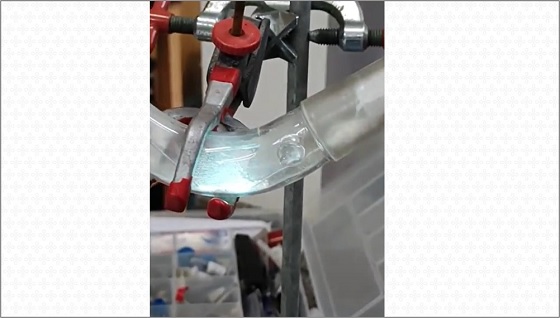Scalable method for producing two-dimensional boron nitride

With the miniaturization of many types of devices, two-dimensional materials become increasingly relevant. However, preparing them on an industrial scale while maintaining their properties is often challenging.
In a recently published article, members of CINE and collaborators present an important contribution to the search for methods that can enable the industrial production of these materials that are few atoms thick.
The authors developed a fast, clean, scalable and simple method to obtain hexagonal boron nitride nanosheets, a material formed by flat layers of boron and nitrogen atoms arranged in the shape of hexagons. To obtain this material in its two-dimensional version, it is necessary to exfoliate it, that is, extract sheets with few layers of thickness, from the macroscopic version. Known as white graphene, hexagonal boron nitride is similar to carbon material in many ways, but is much more difficult to exfoliate.
“In this work, we presented a method of exfoliation of boron nitride crystals in a material with few layers, of nanometric dimensions, by means of the plasma of a modified Tesla coil”, explains researcher Almir Oliveira Neto (Ipen), member of the CINE’s Methane to Products division, which led the research. According to him, the proposed modifications were carried out with the participation of CINE postdocs Rodrigo Fernando B. de Souza (Ipen) and Priscilla J. Zambiazzi (Ipen), while some physical characterizations had the collaboration of researchers from the Center of Materials Science and Technology at Ipen.
The Tesla coil is a simple device, which is capable of producing high voltage discharges (arcs). These electrical discharges ionize the surroundings, forming the so-called “cold plasma”, in which electrons are in a higher energy state than the rest of the particles. Exfoliation of boron nitride by the new method, the authors explain, occurs when electrons are fired against a macroscopic amount of boron nitride. At this point, part of the energy of the electrons is transferred to the crystal structure, which increases the bonding distance between the atomic layers to a point where the bond breaks.
The work, which was entirely carried out at Ipen, can impact several research works that are being developed within the scope of CINE. In fact, like many other two-dimensional materials, few-layers hexagonal boron nitride has interesting properties for renewable energy generation and storage, with applications in catalysis and photocatalysis processes and in devices such as supercapacitors and fuel cells.
Scientific article reference: Facile, clean and rapid exfoliation of boron-nitride using a non-thermal plasma process. Rodrigo F.B. de Souza, Victoria A. Maia, Priscilla J. Zambiazzi, Larissa Otubo, Dolores R. R. Lazar, Almir O. Neto. Materials Today Advances, Volume 12, December 2021, 100181. https://doi.org/10.1016/j.mtadv.2021.100181.
Authors of the article who are members of CINE: Rodrigo F. B. de Souza (post-doc at Ipen), Priscilla J. Zambiazzi (post-doc at Ipen) and Almir O. Neto (tenured researcher at Ipen).
This video shows the arc passing through the boron nitride (white powder) and forming the nanosheets.
Contact

Almir O. Neto
Ipen - Brasil











